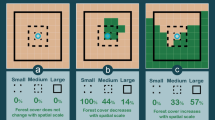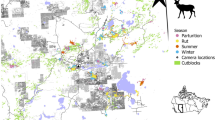Abstract
Organisms may be constrained by the energetic costs incurred while obtaining resources in fragmented landscapes. We used a spatially neutral model of deer wintering habitat to evaluate the effects of landscape fragmentation on the aggregation of deer habitat. The spatially neutral model used Bayesian probabilities to predict where deer wintering areas occurred. The probabilities were conditional on 12 landscape variables measured at 22,750 contiguous 0.4 ha locations. The model predicted deer habitat at each location independently, thereby enabling a comparison of habitat aggregation in observed, simulated, and random distributions of deer habitat. The predictions of the neutral model exhibited greater fragmentation than observed in nature, suggesting that suitable, yet isolated, locations were not visited by deer. The most suitable sites for deer were clumped in the neutral model, regardless of scale. The inclusion of less suitable sites preserved significant aggregation at fine scales but not at broad scales. Species operate at different scales within a landscape, so ecologists, nature reserve designers and natural resource planners may benefit from models that focus on the proximity of habitat sites as a function of both spatial scale and habitat quality.
Similar content being viewed by others
References
Brown, J.H. 1981. Two decades of homage to Santa Rosalia: Toward a general theory of diversity. Am. Zool. 21: 877–888.
Brown, J.H. and Maurer, B.A. 1987. Evolution of species assemblages: Effects of energetic constraints and species dynamics on the diversification of the North American Avifauna. Am. Natur. 130: 1–17.
Burrough, P.A. 1981. Fractal dimensions of landscapes and other environmental data. Nature 294: 241–243.
Burrough, P.A. 1983. Multiscale sources of spatial variation in soil. I. Application of fractal concepts to nested levels of soil variations. J. Soil Sci. 34: 577–597.
Caswell, H. 1976. Community structure: A neutral model analysis. Ecol. Monogr. 46: 327–354.
Charnov, E.L. 1976. Optimal foraging: The marginal value theorem. Theor. Popul. Biol. 9: 129–136.
Connelly, W.J. 1986. Integrating harvest schedules with land management options. In Proceedings of the workshop on lessons from using FORPLAN. April 29–May 1, 1986. pp. 97–109. Edited by R.G. Bailey. Dept. of Agric. Forest Serv., Land Management Planning Syst., Denver, Co. Washington, D.C.
Covich, A.P. 1976. Analyzing shapes of foraging areas: Some ecological and economic theories. Ann. Rev. Ecol. System. 7: 235–257.
Davis, J.C. 1986. Statistics and data analysis in geology. 2nd ed. J. Wiley and Sons, New York.
Evans, R.D. 1974. Wildlife habitat management program: A concept of diversity for the public forests of Missouri. In Timber-Wildlife Symposium. pp. 73–83. Edited by J.P. Slushier and T.M. Hinckley. Missouri Acad. of Science, Occasional Pap. No. 3.
Forman, R.T.T. and Godron, M. 1986. Landscape ecology. J. Wiley and Sons, New York.
Gardner, R.H., Milne, B.T., Turner, M.G. and O'Neill, R.V. 1987. Neutral models for the analysis of broad-scale landscape pattern. Landsc. Ecol. 1: 19–28.
Greig-Smith, P. 1964. Quantitative plant ecology. 2nd ed. Butterworths, London.
Helwig, J.T. and Council, K.A. (eds.). 1979. The statistical analysis system users' guide. SAS Institute, Raleigh, North Carolina.
Kershaw, K.A. 1960. The detection of pattern and association. J. Ecol. 48: 233–242.
Mandelbrot, B. 1983. The fractal geometry of nature. W.H. Freeman and Co., New York.
Meentemeyer, V. and Box, E.O. 1987. Scale effects in landscape studies. In Landscape Heterogeneity and Disturbance. pp. 15–34. Edited by M.G. Turner. Springer-Verlag, New York.
Milne, B.T. 1987. Hierarchical landscape structure and the Forest Planning Model: Discussant's comments. In FORPLAN: An valuation of a Forest Planning Tool. pp. 128–132. U.S.D.A. Forest Service Gen. Tech. Report RM-140.
Milne, B.T. 1988a. Changing landscape patterns. Bull. Ecol. Soc. Amer. 69: 56–58.
Milne, B.T. 1988b. Measuring the fractal geometry of landscapes. Appl. Mathem. Comput. 27: 67–79.
Noy-Meir, I. and Anderson, D.J. 1973. Multiple pattern analysis, or multiscale ordination: Towards a vegetation hologram? In Many Species Populations. Ecosystems, and Systems Analysis. pp. 207–231. Edited by G.P. Patil, E.C. Pielou and W.E. Waters. Statistical Ecology Vol. 3. Penn. State Univ. Press, Univ. Park.
Orbach, R. 1986. Dynamics of fractal networks. Science 231: 814–819.
Palmer, M.W. 1988. Fractal geometry: A tool for describing spatial patterns of plant communities. Vegetatio 75: 91–102.
Peters, R.H. 1983. The ecological implications of body size. Cambridge University Press, New York.
Risser, P.G., Karr, J.R. and Forman, R.T.T. 1984. Landscape ecology: Directions and approaches. Illinois Natural History Survey Spec. Publ. No. 2. Ill. Nat. Hist. Survey, Champaign.
Senft, R.L. 1986. Cattle spatial use of mountain range: Effects of grazing systems and landscape pattern. Proc. Western Section. Amer. Soc. Animal Sci. 37: 231–234.
Senft, R.L., Coughenour, M.B., Bailey, D.W., Rittenhouse, L.R., Sala, O.E. and Swift, D.M. 1987. Large herbivore foraging and ecological hierarchies. BioScience 37: 789–799.
Shugart, H.H. and Gilbert, B.J. 1987. An ecological evaluation of FORPLAN in National Forest Planning. In FORPLAN: An Valuation of a Forest Planning Tool. pp. 122–127. U.S.D.A. Forest Service Gen. Tech. Report RM-140.
Stauffer, D. 1985. Introduction to percolation theory. Taylor and Francis Publ. London.
Urban, D.L., O'Neill, R.V. and Shugart Jr. H.H. 1987. Landscape ecology. BioScience 37: 119–127.
Whittaker, R.H., Levin, S.A. and Root, R.B. 1973. Niche, habitat, and ecotope. Am. Natur. 107: 321–338.
Wiens, J. 1981. Single sample surveys of communities: Are the revealed patterns real? Am. Natur. 117: 90–98.
Author information
Authors and Affiliations
Rights and permissions
About this article
Cite this article
Milne, B.T., Johnston, K.M. & Forman, R.T.T. Scale-dependent proximity of wildlife habitat in a spatially-neutral Bayesian model. Landscape Ecol 2, 101–110 (1989). https://doi.org/10.1007/BF00137154
Issue Date:
DOI: https://doi.org/10.1007/BF00137154




